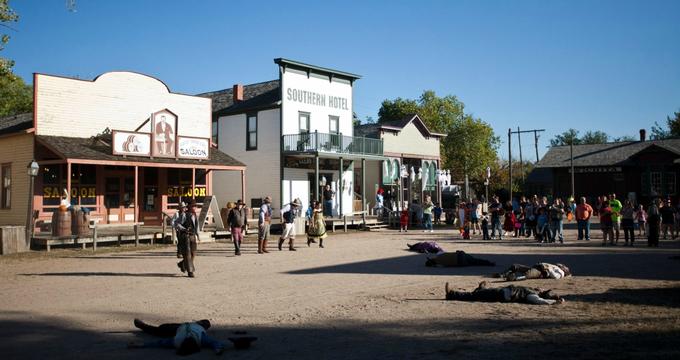Step back in time at the Old Cowtown Museum in Wichita, Kansas—a living history museum that immerses visitors in life from 1865 to 1880 along the famed Chisholm Trail. Spread across 23 acres with more than 50 historical and recreated buildings, costumed interpreters, and live farm animals, Cowtown offers a hands-on, authentic glimpse into the Old West.
I Found This Great For
History Buffs: Explore 19th-century life through real buildings, artifacts, and daily demonstrations.
Families & Kids: Enjoy wagon rides, live farm animals, and interactive blacksmithing and printing demos.
School & Scout Groups: Engage in immersive, curriculum-based programs including classroom sessions in a one-room schoolhouse.
Photographers & Reenactors: Capture or star in authentic Old West portraits with period costumes at Old West Photography.
What to Expect
- Historic Buildings: Wander through 54 structures, including 27 authentic 19th-century buildings relocated from across Kansas.
- Smith House: Tour an 1884 National Folk-style home at the heart of the museum’s working farm.
- Buffalo Hunter Area: Discover early economic life through preserved log cabins and trading posts.
- City Eagle Print Shop & Barbershop: Learn about small-town businesses and how they served both locals and travelers.
- Interactive Demos: Watch live blacksmithing, see 1800s-style printing presses in action, and catch gunfight reenactments on Main Street.
- Horse-Drawn Wagon Rides: Tour the museum the old-fashioned way—on wheels powered by horsepower.
Education & Programs
Old Cowtown Museum brings history to life with engaging educational experiences for students, scouts, and curious minds:
- Guided & Self-Guided Tours: Choose your own pace or follow interpreters through curated experiences.
- History Immersion Experience: Step into the shoes of 1800s entrepreneurs in this guided program focused on frontier life.
- Classroom in the Past: Teachers can lead lessons in the one-room schoolhouse using slates and chalk.
- Scout Programs: Earn history badges through hands-on activities and museum exploration.
- Old Sedgwick County Fair Education Day: A special fall event where students engage with their favorite parts of the museum.
Need to Know
- Location: Near the banks of the Arkansas River and Wichita Art Museum, perfect for a full day of cultural exploration.
- Size: 23 acres with 54 structures, live animals, and a 5-acre working farm.
- Authenticity: Exhibits are based on decades of archival research and feature more than 10,000 artifacts.
- Special Features: Daily activities include costumed storytelling, blacksmithing, wagon rides, and reenactments.
1865 W Museum Blvd, Wichita, KS 67203 | Phone: 316-350-3323
Plan Your Trip


